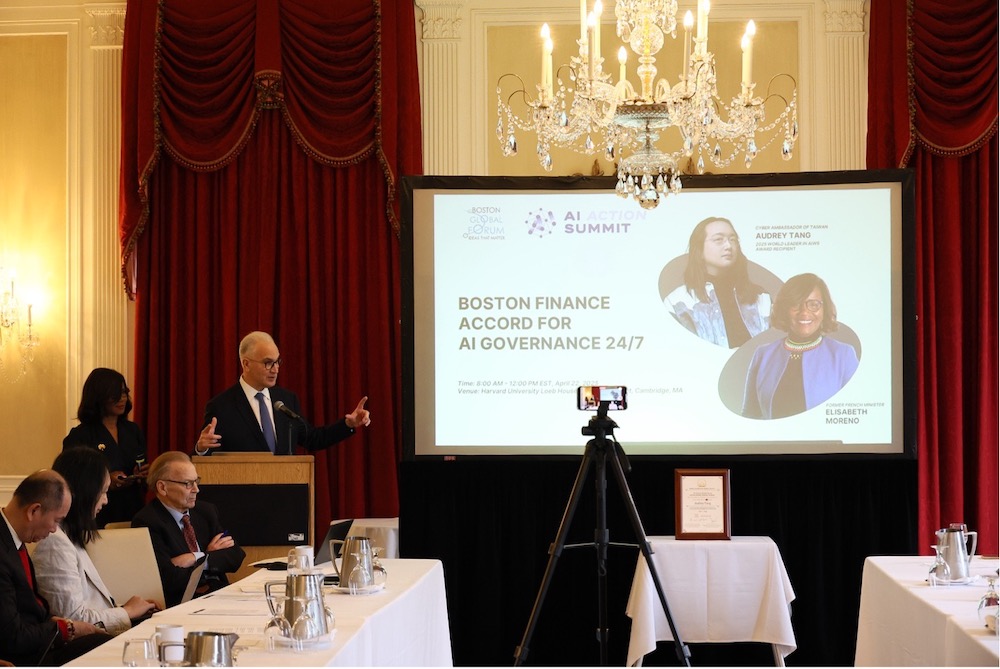Remarks by Hon. Mark Kennedy
Director, Wahba Institute for Strategic Competition
Delivered April 22, 2025 at Boston Global Forum Conference at Harvard University’s Loeb House
A profound realignment is underway—not just in global politics, but in global technology. The world is dividing digitally.
China is accelerating this divide. Its cybersecurity and data laws compel firms to share sensitive information with the state while concealing that access from the world. Its civil-military fusion is fueling an AI-powered buildup with global consequences. The United States has rightly responded—not, as Lenin warned, by selling the rope by which we would be hanged—but by restricting the export of advanced chips and compute infrastructure.
Yet this is not merely a competition of technologies—it is a contest of systems. The question isn’t just who has the fastest model, but who shapes the digital future: its rules, its reach, and its values.
As Secretary Raimondo has made clear, it is no longer realistic for nations to fully participate in both the American and Chinese tech ecosystems. A split is underway. A two-way race has begun.
No third digital pole can match the scale of China or the United States. Only these two powers combine frontier models, advanced compute, and global cloud reach. Here, the U.S. holds a decisive edge: the majority of digital content, scientific research, and training data is in English. That gives American-aligned models a structural advantage in reasoning and global relevance.
The race is ours to lose, but we could still fumble the future if we fail to act strategically.
To win, five steps must guide our AI diplomacy.
Step 1: Build a Trusted Alliance, Not a Fragmented Ecosystem
The Boston Global Forum’s New Economic Alliance reflects a central truth: we cannot go it alone. The U.S. must deepen its partnerships with traditional allies like the UK, Japan, South Korea, and the EU; forge tighter bonds with India; and elevate relationships with rising powers like Vietnam, Brazil, and Kenya.
But two internal risks could fracture this coalition from within.
First, the European Union’s drive to be a regulatory superpower threatens to divide the democratic tech space. While well-intentioned, overly rigid AI rules risk stifling innovation and creating incompatibilities with trusted partners. The answer is not regulatory convergence, but interoperability—allowing systems to work together securely, upholding rights and safety while encouraging innovation.
That’s why the Wahba Institute convened a roundtable in Geneva alongside the WTO’s Global Forum: to explore how we ensure democratic models of AI leadership can remain dynamic, responsive, and aligned across borders.
Step 2: Balance Security with Access
Second, the United States risks overcorrecting. Our export controls currently allow unrestricted chip access to just 18 countries. Left out are 22 NATO allies, India, Israel, and others who could and should be part of our trusted ecosystem. Every country America excludes, China will include.
Security and market access must go hand in hand. Restricting too much, too fast, may undercut U.S. firms, cede ground to China, and drive neutral countries toward Beijing’s orbit.
That’s why we must establish clear, credible pathways for nations to earn access to U.S. models and infrastructure—especially those already aligned with our security interests. Global trust in U.S. companies is a strategic asset. We must not squander it.
Step 3: Lead with a Trusted Open Model
China is not just exporting hardware. It is exporting influence—through code, cloud, and AI models. DeepSeek, Beijing’s open-source large language model, is a prime example. Technically impressive and low-cost, it markets “openness” while tethering its users to censored data, Chinese infrastructure, and continuous dependency.
It follows the Huawei playbook—data absorption disguised as digital inclusion. That is not empowerment. It is entrapment.
To counter this, leaders like Sam Altman and Eric Schmidt have urged the U.S. to back a trusted open-source alternative—one aligned with democratic values, transparent in training, and safe by design. Models like Meta’s LLaMA offer a foundation. America must explore whether with safety guardrails open models can enable trusted partners to innovate responsibly—within an ecosystem that reflects our values.
Whether open or closed, the U.S. must ensure its companies remain the global default—through capability, trust, and accessibility. That requires strategic openness, not reflexive restriction.
Step 4: Extend Shared Infrastructure
Emerging markets want to align with Western technology —but cannot build alone. If we do not help them construct their digital futures, China will gladly sell them one.
We must support shared AI infrastructure across regions like Southeast Asia, Latin America, and Africa. That means co-investing in cloud services, compute access, technical training, and local data governance standards. It means empowering nations to lead their own development while remaining in a trusted, rights-respecting digital sphere.
This is not charity. It is strategy.
Step 5: Embed AI in Economic Statecraft
Finally, we must recognize AI as a pillar of geoeconomic strategy—not just a technical sector. AI will shape trade flows, supply chains, talent development, and alliance structures. It must be embedded in our foreign policy, our coalition-building efforts, and our development assistance agenda.
Unlike China’s state-fused model, America’s innovation system is decentralized, pluralistic, and open. That is a competitive advantage. But we must empower U.S. firms to operate globally in a way that advances the shared interest in a free and trusted digital future.
We must also make a simple distinction clear to the world: U.S. companies are not arms of the state. They are innovators, collaborators, and catalysts of opportunity—not enforcers of central control.
In conclusion:
The Boston Global Forum’s New Economic Alliance captures the challenge and the opportunity. AI is not just a technology. It is a test—of whether open societies can cooperate at the speed of innovation.
To pass that test, we must do more than set standards.
We must share tools.
We must share compute.
We must share responsibility.
And we must lead not just through innovation—but through engagement.
Thank you.
